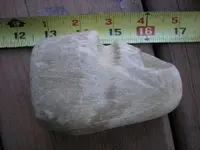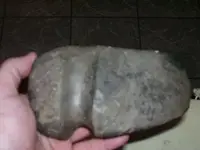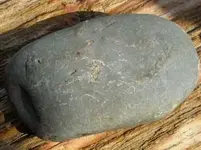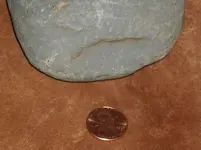You are using an out of date browser. It may not display this or other websites correctly.
You should upgrade or use an alternative browser.
You should upgrade or use an alternative browser.
stone ax
- Thread starter dugit
- Start date
unitas
Hero Member
It doesnt appear to be an ax. It should have a sharp bit,sorry.
FutureProspect784
Jr. Member
- Joined
- Sep 22, 2007
- Messages
- 32
- Reaction score
- 0
- Golden Thread
- 0
- Location
- Prince Edward Island
- Detector(s) used
- Bounty Hunter 'somethingorother'.
Could be an axe. I've seen a few which are quite rounded. Are there any grooves or indentations where it may have been attached to something?
vibes
Bronze Member
- Joined
- Aug 20, 2007
- Messages
- 2,092
- Reaction score
- 54
- Golden Thread
- 0
- Location
- Northern Indiana
- Detector(s) used
- Fisher 1280x Aquanaut
The Grim Reaper
Gold Member
- Joined
- Apr 3, 2008
- Messages
- 7,805
- Reaction score
- 7,068
- Golden Thread
- 0
- Location
- Southern Ohio
- Primary Interest:
- All Treasure Hunting
vibes, your is definitely the start of one. You can see where they have started the groove and you can also see the outline of the shape beginning to take form.
As for dugits, it's hard to tell from the picture, but my first inclination is to say no.
As for dugits, it's hard to tell from the picture, but my first inclination is to say no.
*Molly*
Silver Member
Hi Dugit, Welcome.
I have to agree with Steve, I can see now signs of workmanship. I've also found stones like that on the campsite I hunt, but as I said, with no real signs of workmanship, then its probably just a rock.
Just my opinion.
Molly.
I have to agree with Steve, I can see now signs of workmanship. I've also found stones like that on the campsite I hunt, but as I said, with no real signs of workmanship, then its probably just a rock.
Just my opinion.
Molly.

Cannonman17
Bronze Member
First one no, second one looks like a maul. Can you scan or take a pic of the other side?
A
Atlantis0077
Guest
Afternoon,
Yep gotta agree with Cannonman. Not an axe...could be some type of hammerstone or maul. Find tons of those things in the archaic village areas here. Some are polished and pretty nice, others rather crude. Here is a photo of a a pretty large axe from the Toledo Lake area in Sabine Parish. Where you find such stones as yours, there should be points as well.
Happy Hunting,
Atlantis
Yep gotta agree with Cannonman. Not an axe...could be some type of hammerstone or maul. Find tons of those things in the archaic village areas here. Some are polished and pretty nice, others rather crude. Here is a photo of a a pretty large axe from the Toledo Lake area in Sabine Parish. Where you find such stones as yours, there should be points as well.

Happy Hunting,
Atlantis
Attachments
Ohio_Doug
Hero Member
dugit said:This is the other side.
Definetly looks like something from that pic, the recess certainly looks man made.
luckyinkentucky
Full Member
Hey dugit ... show a pic of the recess, and that will give us a better idea what we are looking at. Thanks.
WhiteCountyPaleo
Hero Member
- Joined
- Jul 21, 2008
- Messages
- 546
- Reaction score
- 76
- Golden Thread
- 0
- Location
- Lafayette, IN
- Detector(s) used
- AT PRO
Cannonman is right, Vibes that looks like a maul. I was gonna ask the same thing. Vibes, you should show the other side and both ends.
Cannonman17
Bronze Member
From what I can see on either side it appears to be natural. I wouldn't confirm it without holding it in hand but my best gues says it is.
Not to be a smart aleck but, I've been told numerous times on this forum that how a rock fits in your hand has absolutely no bearing on it being a tool.  Got to go with the looks.
Got to go with the looks.
IMO,,I think the ancients sometimes had numerous uses for the same tool. A rock could have been a hammerstone, grinding tool, base grinding stone, or a (?) depending on the needs at the time. The original multi-tool. I find pestles that have a smooth side that was probably used for grinding, and another side that batters or hammers. To me it makes sense.
Without holding it, and feeling how it was used. I will not rush to judgement and say 'Just a Rock'.
 Got to go with the looks.
Got to go with the looks. IMO,,I think the ancients sometimes had numerous uses for the same tool. A rock could have been a hammerstone, grinding tool, base grinding stone, or a (?) depending on the needs at the time. The original multi-tool. I find pestles that have a smooth side that was probably used for grinding, and another side that batters or hammers. To me it makes sense.
Without holding it, and feeling how it was used. I will not rush to judgement and say 'Just a Rock'.
Cannonman17
Bronze Member
Shemanese said:Not to be a smart aleck but, I've been told numerous times on this forum that how a rock fits in your hand has absolutely no bearing on it being a tool.Got to go with the looks.
IMO,,I think the ancients sometimes had numerous uses for the same tool. A rock could have been a hammerstone, grinding tool, base grinding stone, or a (?) depending on the needs at the time. The original multi-tool. I find pestles that have a smooth side that was probably used for grinding, and another side that batters or hammers. To me it makes sense.
Without holding it, and feeling how it was used. I will not rush to judgement and say 'Just a Rock'.
Okay- just trying to help.
I don't think I rushed to judgement, I looked at both sides and see no use wear polish, no peck marks, no striations in the sruface, no obvious shaping of any sort and that's really what I look for since mother nature, lakes and rivers in particular, had the habbit of making so many look alikes, ones that fit just right in the hand too!
 I also believe that the "ancients" sometimes had multi tools but I draw my conclusions on such things from a multitude of site reports I have gone through over the years as well as field experience, not imagination or opinion. I can say without a doubt that the most common of multi tools was the utilized flakes but these can be proven by seeing the flaking scars, the material, use wear analysis and all that. Now on the other hand you get quite a few people who find water polished rocks of all sizes and shapes to look like axes or "something" and in many ways they really do. I'm all but sure that the natives would've headed to the nearest river to find some of these same stones when they wanted to make one but as soon as they started to make one, finished or not, they left evidence of it on the surface of the stone, that's why I say looking at it closely is far more important that how it feels in the hand. I can go to Lake Michigan and find beach polished cobbles that are about the size of an axe and feel and fit "JUST RIGHT" in my hand but they are still nothing more than cobbles. Find an axe or other ground stone tool and there will be no doubt, no question, that it was an axe, signs are usually very clear with rare exception. Now one might argue that this, or any other cobble for that matter, must have been used because there's no river close by, no other rocks like this in the area, it was found right in a camp, etc etc and each has some validity to it but only to a certain point. Finding rocks where no other similar ones are found typically doens't mean much as does finding one away from a river or what not, United States has been here for like five billion years or so and stuff moves around a lot plain and simple. Finding a rock like this IN a camp site is only a slightly better arguement. It does increase the over all odds of being something I suppose but I will guarentee that there were rocks under and/or in nearly every camp site in the united states before the natives lived there so finding one in a camp doesn't automatically make it one. What about as a hammer stone, they could've crushed up bark or pounded stakes with it and I would never know- well, sort of. You can pick up a normal rock and pound a stake or two in the ground, perhaps crush up some bark in a wood bowl or some other similar use HOWEVER if you repeatedly do this I will be able to tell as most rocks will start to leave tell tale signs in pretty quick order, all depends on the hard/soft the stone is. This cobble you show appears to be releatively soft, another reason I believe the signs of use would be much stronger. I do have to concede that this and others like it could've been used a few times for various tasks without leaving enough evidence on the surface for me to be able to tell, and if that's the kind of "maybe" artifacts a person wants to collect that's okay too it's just not for me or most serious collectors I don't think. Crud, I just re read your post and I have to ellaborate a little more.
I also believe that the "ancients" sometimes had multi tools but I draw my conclusions on such things from a multitude of site reports I have gone through over the years as well as field experience, not imagination or opinion. I can say without a doubt that the most common of multi tools was the utilized flakes but these can be proven by seeing the flaking scars, the material, use wear analysis and all that. Now on the other hand you get quite a few people who find water polished rocks of all sizes and shapes to look like axes or "something" and in many ways they really do. I'm all but sure that the natives would've headed to the nearest river to find some of these same stones when they wanted to make one but as soon as they started to make one, finished or not, they left evidence of it on the surface of the stone, that's why I say looking at it closely is far more important that how it feels in the hand. I can go to Lake Michigan and find beach polished cobbles that are about the size of an axe and feel and fit "JUST RIGHT" in my hand but they are still nothing more than cobbles. Find an axe or other ground stone tool and there will be no doubt, no question, that it was an axe, signs are usually very clear with rare exception. Now one might argue that this, or any other cobble for that matter, must have been used because there's no river close by, no other rocks like this in the area, it was found right in a camp, etc etc and each has some validity to it but only to a certain point. Finding rocks where no other similar ones are found typically doens't mean much as does finding one away from a river or what not, United States has been here for like five billion years or so and stuff moves around a lot plain and simple. Finding a rock like this IN a camp site is only a slightly better arguement. It does increase the over all odds of being something I suppose but I will guarentee that there were rocks under and/or in nearly every camp site in the united states before the natives lived there so finding one in a camp doesn't automatically make it one. What about as a hammer stone, they could've crushed up bark or pounded stakes with it and I would never know- well, sort of. You can pick up a normal rock and pound a stake or two in the ground, perhaps crush up some bark in a wood bowl or some other similar use HOWEVER if you repeatedly do this I will be able to tell as most rocks will start to leave tell tale signs in pretty quick order, all depends on the hard/soft the stone is. This cobble you show appears to be releatively soft, another reason I believe the signs of use would be much stronger. I do have to concede that this and others like it could've been used a few times for various tasks without leaving enough evidence on the surface for me to be able to tell, and if that's the kind of "maybe" artifacts a person wants to collect that's okay too it's just not for me or most serious collectors I don't think. Crud, I just re read your post and I have to ellaborate a little more. On the idea of multi tools, there certainly are some found consistantly throughout the archaeological record, most frequently it's a flake tool. They are found in every state and almost every site. I can almost picture the modern day infomercial for one, it slices! it dices! it scrapes and cleans! You can even preform surgery with one, wait, it doesn't stop there! Not into surgery? How about engraving? Stop letting your mother in law steal your pots, mark them and keep track of yours! This flake tools have been used for it all really, scanning electron microscopes have been able to recognize a large number of uses from cutting meat to scraping hides, to etching bone or antler, etc. Outside of utilized flakes the number and variety of multi tools drops, most tools in fact (IMO) were fairly well specialized for a specific task. Hammer stones may have been used to hammer a variety of materials, seeds, bark, etc but none the less the tool is the same. Please don't be offended by this because I'm SURE I HAVE DONE THIS MANY TIMES TOO but... many people, untrained people in particular, find an artifact, a real one and look at it. They might not know what it is right away and most have a genuine curiosity of it... then one of two things happens, 1) Something pops into that persons head as to what it might be used for, the key word here being might. Problem is from that point on it's considered fact by many and even passed on to as being such. 2) Grandpa or Uncle Bob shows up (and having found one similar years ago and having gone through the same thing) and proudly states that he knows EXACTLY what that thing is, he's found them before (making him the expert) and it too gets passed on as fact. Okay, I went back and read what you wrote before going on, I udnerstand what you're saying now, at first I read it as the base or mortar had been used to hammer stuff with, the pestle on the other hand makes perfect sense, acorns would be a perfect candidate, use the top end to crack em and the smooth side to flour them. At any rate- I should also through in the fact that when I thought it was a maul I was talking about the other stone posted after this one, that one looked worked and used but then later I realized that wasn't from the original poster.
Sorry for going on and on.

Similar threads
- Replies
- 2
- Views
- 463
- Replies
- 6
- Views
- 618
Users who are viewing this thread
Total: 1 (members: 0, guests: 1)








